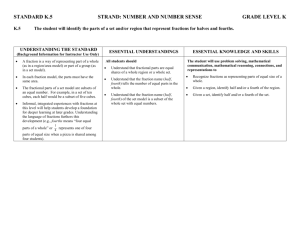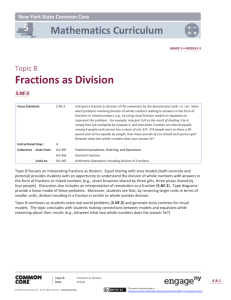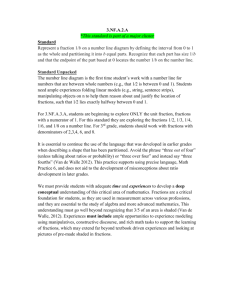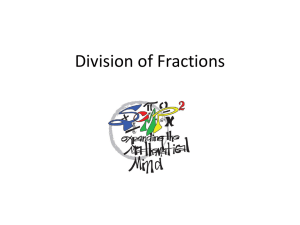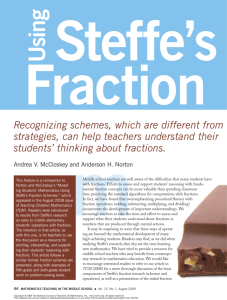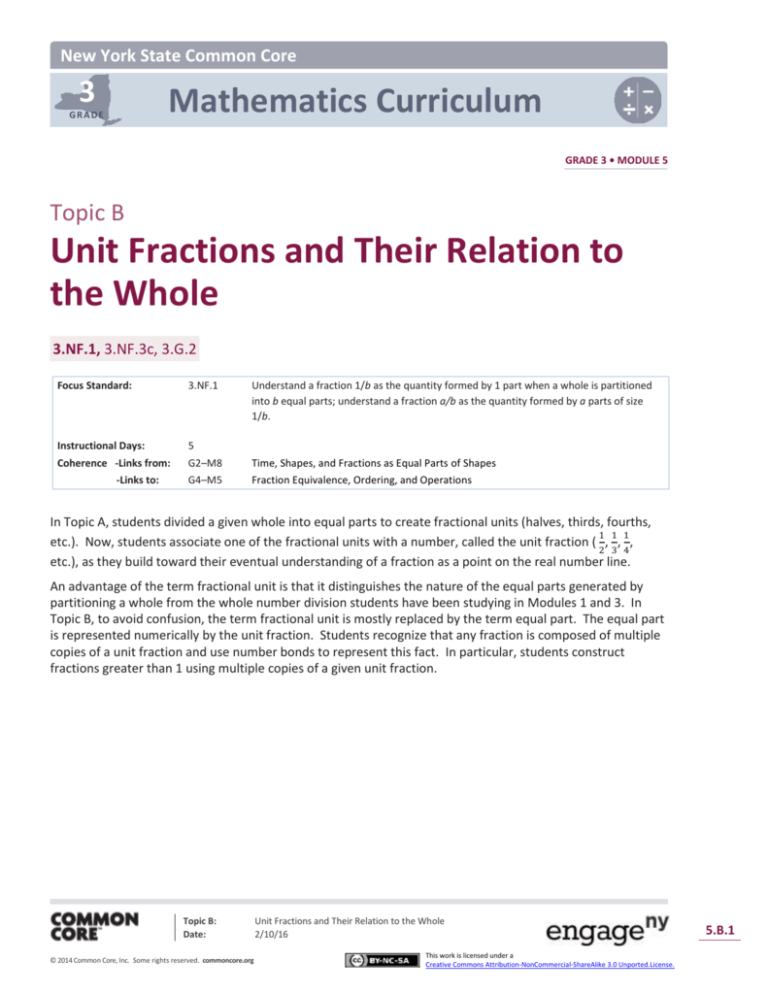
New York State Common Core
3
x
Mathematics Curriculum
GRADE
GRADE 3 • MODULE 5
Topic B
Unit Fractions and Their Relation to
the Whole
3.NF.1, 3.NF.3c, 3.G.2
Focus Standard:
3.NF.1
Instructional Days:
5
Coherence -Links from:
G2–M8
Time, Shapes, and Fractions as Equal Parts of Shapes
G4–M5
Fraction Equivalence, Ordering, and Operations
-Links to:
Understand a fraction 1/b as the quantity formed by 1 part when a whole is partitioned
into b equal parts; understand a fraction a/b as the quantity formed by a parts of size
1/b.
In Topic A, students divided a given whole into equal parts to create fractional units (halves, thirds, fourths,
1 1 1
etc.). Now, students associate one of the fractional units with a number, called the unit fraction ( 2, 3, 4,
etc.), as they build toward their eventual understanding of a fraction as a point on the real number line.
An advantage of the term fractional unit is that it distinguishes the nature of the equal parts generated by
partitioning a whole from the whole number division students have been studying in Modules 1 and 3. In
Topic B, to avoid confusion, the term fractional unit is mostly replaced by the term equal part. The equal part
is represented numerically by the unit fraction. Students recognize that any fraction is composed of multiple
copies of a unit fraction and use number bonds to represent this fact. In particular, students construct
fractions greater than 1 using multiple copies of a given unit fraction.
Topic B:
Date:
© 2014 Common Core, Inc. Some rights reserved. commoncore.org
Unit Fractions and Their Relation to the Whole
2/10/16
This work is licensed under a
Creative Commons Attribution-NonCommercial-ShareAlike 3.0 Unported.License.
5.B.1
Topic B 3 5
NYS COMMON CORE MATHEMATICS CURRICULUM
A Teaching Sequence Toward Mastery of Unit Fractions and Their Relation to the Whole
Objective 1: Partition a whole into equal parts and define the equal parts to identify the unit fraction
numerically.
(Lesson 5)
Objective 2: Build non-unit fractions less than one whole from unit fractions.
(Lesson 6)
Objective 3: Identify and represent shaded and non-shaded parts of one whole as fractions.
(Lesson 7)
Objective 4: Represent parts of one whole as fractions with number bonds.
(Lesson 8)
Objective 5: Build and write fractions greater than one whole using unit fractions.
(Lesson 9)
Topic B:
Date:
© 2014 Common Core, Inc. Some rights reserved. commoncore.org
Unit Fractions and Their Relation to the Whole
2/10/16
This work is licensed under a
Creative Commons Attribution-NonCommercial-ShareAlike 3.0 Unported.License.
5.B.2

